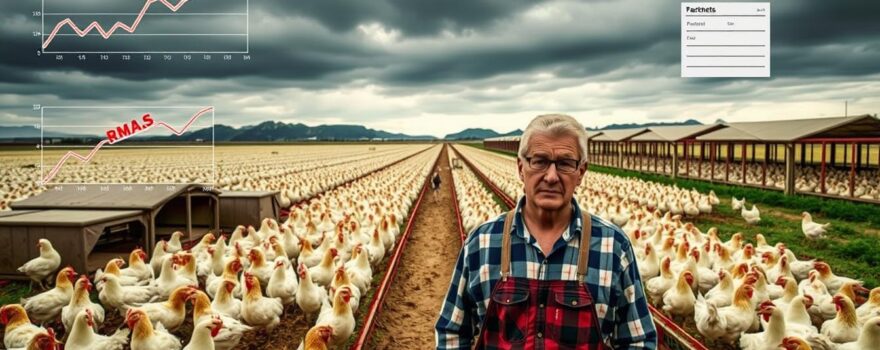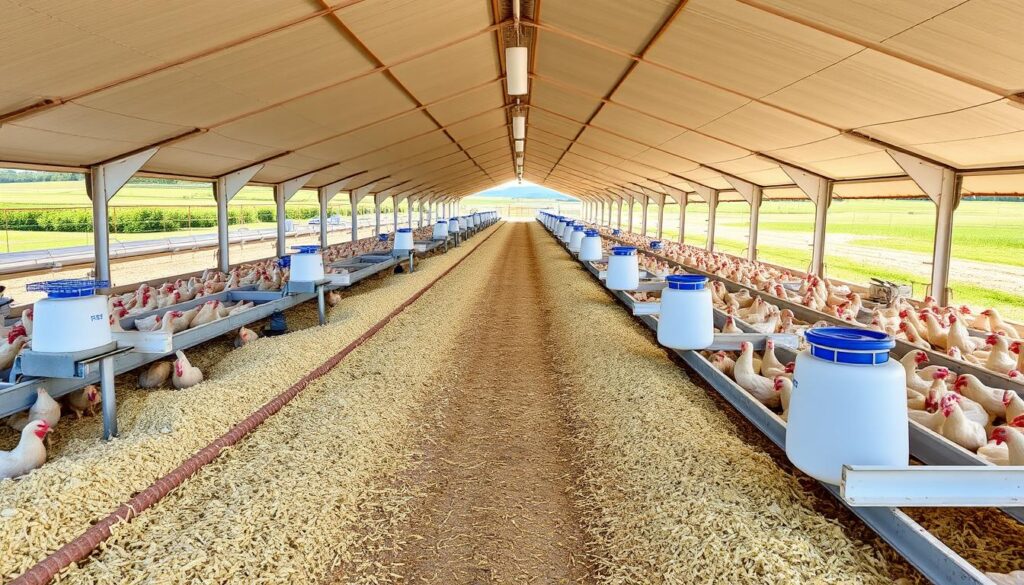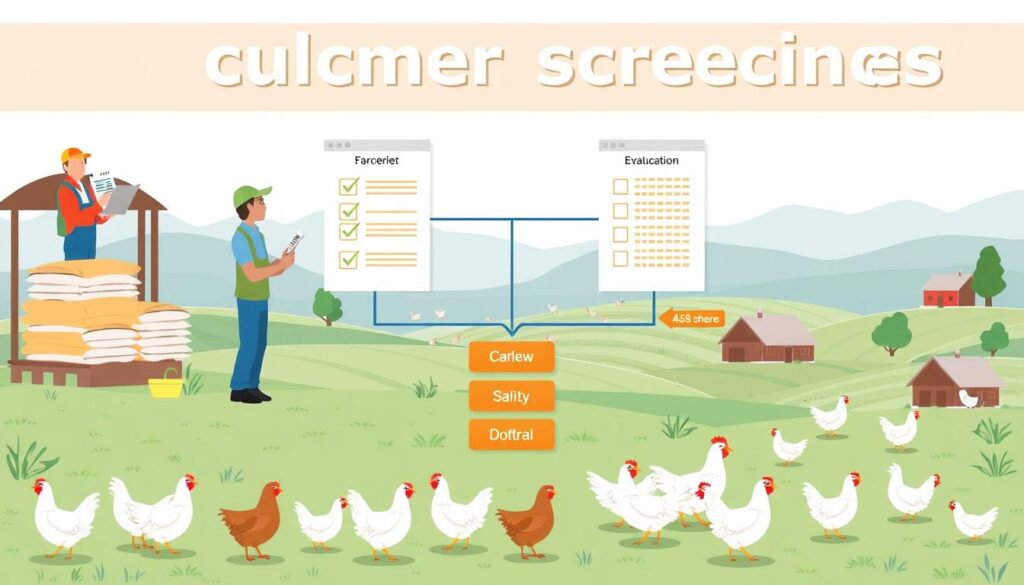
The U.S. broiler production industry is unique. Almost all broilers are raised by farms under contract with poultry integrators. These growers provide the capital, utilities, and labor. Meanwhile, integrators give chicks, feed, transportation, veterinary services, and technical guidance.
Contract fees make up most of growers’ income. However, the income range among contract broiler growers is quite wide. This is compared to the overall farm population or U.S. households.
This income difference is due to various factors. Off-farm income, production scale, and the contract payment system play roles. Poultry companies handle the price risks for feed and chicken meat. But, production risks like weather and disease fall on the company, not the grower.
Key Takeaways
- Contract broiler growers earn average household incomes substantially exceeding those of all-farm and all U.S. households.
- The spread of household incomes among contract growers is wider than for all farm households and all U.S. households, indicating the financial risks associated with contract production.
- Off-farm income accounts for approximately half of the total household income earned by contract growers, contributing to the overall income variability within this group.
- The design of tournament contracts introduces new financial risks to farmers, impacting their household incomes.
- Accurate record-keeping and regular animal weighing are crucial to minimize financial risks in broiler farming.
Understanding the Unique Structure of U.S. Broiler Production
The broiler chicken industry in the United States is special. Almost all broilers are raised by farms under contract with big poultry companies. This setup has shaped the contract farming in broiler chicken industry and the broiler production contract system.
Broiler Farming Contract System Overview
In this system, contract broiler growers handle the costs, housing, and labor for raising chickens. Meanwhile, poultry integrators give the chicks, feed, and technical help. The contract fees are a big part of the growers’ income, showing how unique the U.S. broiler production is.
Roles of Contract Growers and Poultry Integrators
Contract broiler growers take care of the facilities and animal welfare. They also follow the integrator’s rules. Poultry integrators provide the inputs, technical support, and process the birds for sale. This partnership is key to the U.S. broiler production’s success.
“Broiler production has experienced high rates of productivity growth and new product innovation leading to high growth rates in production, consumption, and exports.”
The U.S. broiler industry’s contract-based structure has led to big improvements. It has driven growth in production, consumption, and exports of broiler meat over the years.
Why Broiler Grower Incomes Vary Widely
The income of contract broiler growers varies a lot. This is mainly because of their off-farm income. On average, this income makes up about half of their total household earnings. This is more than for most farms or U.S. households.
Off-farm income comes from jobs outside the farm, investments, or other businesses. It’s key to their financial health.
The tournament-style contract payment system also affects their income. Growers are paid based on how they compare to others, not just their own performance. This can cause big differences in what they earn, even if they farm the same way.
Impact of Off-Farm Income on Household Income
Off-farm income is very important for contract broiler growers. This income can be up to half of their total earnings. It helps balance out the risks and ups and downs of broiler farming.
By having different income sources, growers can handle financial risks better. This keeps their finances more stable.
Tournament-Style Contract Payment System
- Growers are paid based on how they compare to others delivering chickens to the same company.
- This system can cause big differences in pay, even among growers who farm similarly.
- The tournament-style payment adds to the wide range of incomes among broiler growers.
The mix of off-farm income and the tournament-style payment system leads to a wide range of incomes. Knowing these factors affecting broiler grower income is key. It helps both current and new growers manage their financial risks.
“Grower pay varies widely around average pay estimates due to circumstances outside the grower’s control, such as the performance of other growers.”
Mitigating Operational Risks Before Chick Arrival
Managing risks in broiler chicken farming starts before chicks arrive. This early stage focuses on two main areas. First, preparing the housing for the chicks’ needs. Second, setting up strict biosecurity to avoid disease outbreaks.
Preparing Housing and Ensuring Biosecurity
Getting the poultry houses ready for chicks is key. This means cleaning and disinfecting, ensuring good air, temperature, and humidity. Also, setting up feeders and drinkers is important.
Good environmental conditions are vital for the chicks’ health and growth. Along with physical setup, strong biosecurity is crucial. This includes controlling who enters the farm, wearing protective gear, and keeping everything clean.
Accurate Data Management and Issue Resolution
Keeping detailed records of broiler production is essential. Farmers should track feed, water, growth, and health issues. This data helps spot and fix problems fast.
Quickly solving any issues is vital. Whether it’s broken equipment, disease, or other problems, acting fast helps keep the flock healthy. Using data and quick action helps farmers manage risks and keep operations running smoothly.

| Biosecurity Measure | Description |
|---|---|
| Access Restrictions | Limiting access to the farm, requiring visitors to wear protective gear, and maintaining a log of all visitors. |
| Sanitation Practices | Regularly cleaning and disinfecting the poultry houses, equipment, and common areas to prevent the spread of diseases. |
| Flock Monitoring | Closely observing the chicks for any signs of illness or distress and promptly addressing any health concerns. |
| Waste Disposal | Proper handling and disposal of dead birds, litter, and other waste to minimize the risk of disease transmission. |
By tackling operational risks early, like preparing housing and implementing biosecurity, farmers can ensure a successful flock. Keeping accurate data and solving issues quickly is key to a productive flock.
Managing Environmental Risks Within Poultry Houses
The success of a broiler chicken farm depends on the environment in the poultry houses. Bad temperature, humidity, and ammonia levels can harm the birds. This can lead to stress, slow growth, and even death.
Keeping the temperature and humidity right is key. The ideal temperature is between 70-75°F, and humidity should be 50-70%. If these conditions are off, the birds’ health and work can suffer. Ammonia, from bird waste, also needs to be watched closely. Too much ammonia can hurt the birds’ breathing and weaken their immune system.
| Environmental Factor | Optimal Range | Potential Risks |
|---|---|---|
| Temperature | 70-75°F | Stress, reduced growth, high mortality |
| Humidity | 50-70% | Respiratory issues, disease susceptibility |
| Ammonia | Below 25 ppm | Respiratory problems, weakened immunity |
To manage these risks, farmers need good monitoring and control systems. They should use sensors, ventilation, and ammonia detectors. Regular cleaning and litter management also help keep ammonia levels down.
By tackling environmental risks, farmers can keep their birds healthy and productive. This improves the farm’s profit and sustainability.
“Effective environmental risk management is the cornerstone of successful broiler chicken farming. Carefully controlling temperature, humidity, and ammonia levels is essential for ensuring the well-being of the birds and maximizing the farm’s productivity.”
How to Manage Financial Risks in Broiler Chicken Farming
Managing financial risks in broiler chicken farming is key to success. It involves optimizing production planning, onboarding new partners, improving production processes, and ensuring fair profit-sharing. These steps help farmers face challenges and keep their business stable.
Optimizing Production Planning and Partner Onboarding
Forecasting production capacity is vital to match supply and demand. It’s important to carefully choose partners based on their skills and financial health. Regular checks on production and clear RHPP (Rekapitulasi Hasil Pemeliharaan Peternak) management help spot and fix problems early.
Strengthening Production Processes and Profit Sharing
Improving production process optimization can save costs and boost efficiency. Good biosecurity measures prevent diseases, which can harm finances. Fair profit-sharing in contract broiler farming builds trust and ensures long-term success.
| Key Financial Risk Management Strategies | Potential Benefits |
|---|---|
| Accurate production planning and partner assessment | Balanced supply and demand, successful partnerships |
| Continuous monitoring and transparent RHPP management | Early issue identification and resolution |
| Optimized production processes and biosecurity measures | Improved efficiency, cost savings, and disease risk mitigation |
| Fair profit-sharing in contract broiler farming | Fostered trust and long-term partnership sustainability |
By using these financial risk management strategies for broiler chicken farming, producers can stay resilient and profitable despite challenges.
Customer Selection and Accounts Receivable Management
Managing risks in broiler chicken farming goes beyond just operations and the environment. It also means choosing the right customers and managing their payments well. Good customer screening and smart handling of risky payments are key to keeping cash flow healthy and avoiding losses.
Rigorous Customer Screening for Sales Success
Before working with customers, broiler farmers need to check their credit and payment history. This customer screening process looks at things like financial stability and past payments. By carefully picking customers, farmers can avoid problems with late or missing payments, which can hurt their finances.
Proactive Management of High-Risk Receivables
Even with careful customer choice, managing high-risk receivables is a challenge in the poultry business. Farmers can use strategies like clear talks, payment plans, and legal steps to deal with defaults. By being proactive and using good collection methods, farmers can keep their finances stable.
| Key Considerations | Strategies for Success |
|---|---|
| Customer Creditworthiness |
|
| High-Risk Receivables |
|

By focusing on customer selection and managing accounts receivable well, broiler farmers can reduce financial risks. This helps keep their poultry business healthy and sustainable.
Leveraging Technology to Reduce Residual Risks
The broiler chicken farming industry has made big strides. It uses advanced technologies to tackle long-standing risks. By using computer vision and predictive modeling, farmers get better insights. They can improve their production and make their operations more resilient.
Computer Vision for Accurate Weight Tracking
Measuring bird weights accurately is a big challenge for farmers. Computer vision technology has changed this. It allows for real-time, non-invasive weight monitoring without manual sampling. Cameras track bird growth, giving farmers detailed data for better decisions.
Predictive Modeling for Optimized Selling Prices
Live bird pricing can be unpredictable, affecting farmers’ profits. Predictive modeling helps with this. It uses machine learning and data analytics to forecast prices. This helps farmers sell at the right time, increasing their earnings.
These technologies are a big step for the broiler chicken farming industry. They give farmers real-time data for better decisions. This leads to more efficient production and stronger poultry farming operations.
| Metric | 2017 | 2022 | Percentage Change |
|---|---|---|---|
| Global Chicken Meat Production | 91.1 million tons | 105.9 million tons | 16.2% increase |
| Feed Efficiency Ratio (kg feed/kg gain) | 1.80 | 1.65 | 8.3% improvement |
| Broiler Chicken Population in Sub-Saharan Africa | 6.4 billion | 7.2 billion | 12.5% increase |
Insurance Coverage: A Crucial Safety Net
In the world of broiler chicken farming, having good insurance is key. Risks like disease outbreaks, natural disasters, and unexpected events are common. The right insurance can be a big help for farmers.
Choosing a trusted insurance provider that knows the poultry industry is important. Poultry farm insurance and insurance coverage for broiler chicken farming offer many benefits. These include:
- Protection against financial losses due to disease outbreaks or other production disruptions
- Coverage for damage to poultry houses and equipment caused by natural disasters
- Liability coverage for third-party claims related to the farm’s operations
- Assistance with managing risks and implementing effective risk mitigation strategies
By managing risks through insurance in the poultry industry, farmers can improve their operations. They can do this knowing their investments and livelihoods are safe. This approach helps poultry producers deal with the industry’s challenges and grow their businesses.
“Investing in the right insurance coverage is not just about protecting your assets; it’s about building resilience and securing the future of your poultry farm.”
As the demand for poultry products keeps rising, insurance coverage for broiler chicken farming is more important than ever. By managing risks and getting the right insurance, farmers can succeed. They can face challenges and take advantage of new opportunities in this fast-changing industry.
Managing financial risks in broiler chicken farming needs a detailed and forward-thinking plan. It must tackle operational, environmental, and strategic challenges. By understanding the U.S. broiler system, farmers can reduce risks and improve their chances of success.
To risk mitigate in the poultry industry, farmers should focus on better planning, stronger biosecurity, and smart financial management. Using data to guide decisions is also key. This way, farmers can protect their businesses and help the U.S. broiler chicken industry grow.
The broiler industry is important for jobs, revenue, and local economies. Adopting strong risk management strategies in broiler chicken farming is essential. It ensures the industry’s long-term success and prosperity.